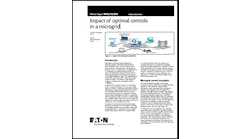Tripp Hathaway, sales and marketing manager for Hannah Solar Government Services, explores a formula for the military to value energy resiliency from a dollars and cents perspective.
Recently, I attended three back-to-back events with a focus on energy resiliency, especially for the Department of Defense (DoD). The U.S. military has been very clear in the last few years about its need for energy resiliency. To the DoD, energy resiliency means that it has energy to power its critical infrastructure in support of our nation’s defense despite interruptions to energy supply from the traditional grid. But there is a problem: We haven’t figured out how to value resiliency in relation to the cost of traditional energy. If we put a dollar value on resiliency, what would that value be? Frankly, I lost count of the number of times the question was asked in the last month. Admittedly, this is a complicated and deeply subjective issue.
But it is certainly solvable.
The energy resiliency equation
The concept of valuing resiliency is not complicated at all. In 2013 Amazon’s online store went down for 49 minutes, costing the company nearly $5M in lost sales. This isn’t an example of energy resiliency, but it is a perfect parallel when trying to value resiliency. The Amazon example shows that there are two elements to valuing the resiliency of their website against outages: time and cost. If we were to turn the value of resiliency into an equation it would look like this:
Value of Resiliency = Cost of Failure/Unit of Time
It cost Amazon $5M for every hour of outage in 2013. Therefore, the value of a resilient online store for Amazon in 2013 was $5M/hour.
It was very easy for Amazon to know the cost of the sales that were missed during the outage. But what is the cost to national security when a critical military facility is offline due to lack of power? This is where the value of energy resiliency for the military gets extremely subjective and theoretical. Nevertheless, the best way for industry to effectively meet the energy resiliency needs of the military is to have an answer to this question.
All branches of the military have built energy resiliency into their mission in one way or another by installing distributed renewable energy generation, building military microgrids, and establishing cybersecurity requirements for their energy systems.
The cost variable
So, how do we pin down a value? I don’t pretend to know the answer, but would like to pose a possible solution. National defense is such a broad topic, that valuing the cost to national defense when the grid is down must start from our military’s senior leadership. There are distinct lines of effort that contribute to our national defense. Of course, the specifics behind these lines of effort are highly classified. So, to paint the picture, let’s just say one line of effort is defeating terrorism, another is defense against intercontinental ballistic missiles (ICBM), and another is readiness for contingency operations. What would it cost our country if one of these lines of effort failed?
This will inevitably involve some wargaming and dramatic hypotheticals. But there is real data out there. For example, we can calculate the hard costs of rebuilding after the terrorist attacks on 9/11. We can also extrapolate the cost of national security failures from historical events in other parts of the world. A nuclear ICBM strike against a US city might resemble the atomic bomb strikes against Japan by the US at the end of WWII. Figuring the cost of total failure of a line of effort of national defense sounds like an extreme exercise, but it is essential for getting to the incremental cost of failure down the chain of command.
Once the cost of failure is defined at the strategic level, each link in the chain of command within that line of effort can determine its portion of the cost of failure. Commanders and leaders prioritize their subordinate lines of effort, which then determine how much weight is placed on their cost of failure. This continues until we get to the facility level. We started at a few strategic lines of effort, and we end at thousands of facilities across the globe that support our national defense. Facilities that support more critical lines of effort represent a higher cost of failure. Each facility would know that they represent a certain tiny percentage of the total cost of failure at the strategic level and would be able to determine the cost of failure at their facility.
The time variable
The good news is that the time variable in the resiliency equation has already been established. For example, The US Air Force has set a standard for its energy resiliency projects such that its critical facilities must be able to operate on their own for seven consecutive days. The US Army’s standard is 14 days. In the renewable energy and microgrid industries, we would call these standards “days of autonomy.”
Having even a partial answer to the value of resiliency by quantifying the time variable with the required days of autonomy, the industry is able to provide solutions that meet that standard. On-site energy generation can be sized to provide power without additional fuel during that period, energy storage can be designed to hold enough energy through load cycles, and controls can be programmed to match generation and load. There is a right answer out there, and quantifying the time variable leads to it. Leaving the cost variable undetermined, however leaves both the military and industry playing guessing games.
The threat
The director of national intelligence, Daniel Coats, delivered a testimony to the Senate Select Committee on Intelligence on Jan. 29 of this year. In his testimony, he briefed that both China and Russia have the capability to launch cyber attacks that cause “localized, temporary, disruptive effects on critical infrastructure.” Our power grid is particularly vulnerable.
Our military understands this threat intimately. It is the reason military leaders have placed such a high priority on energy resiliency and why they have set standards for days of autonomy. All branches of the military have built energy resiliency into their mission in one way or another by installing distributed renewable energy generation, building military microgrids, and establishing cybersecurity requirements for their energy systems. Industry is poised and ready to continue serving the requirement for energy resiliency. Quantifying the cost variable in the value of resiliency equation will enable even more expedient and effective solutions.
Tripp Hathaway is the sales marketing manager for Hannah Solar Government Services.







